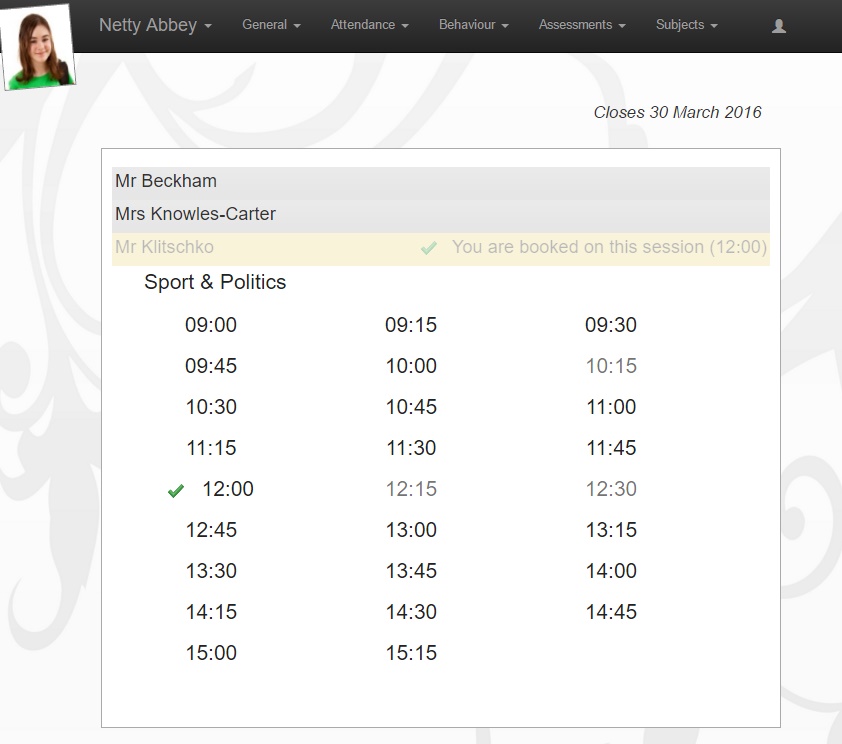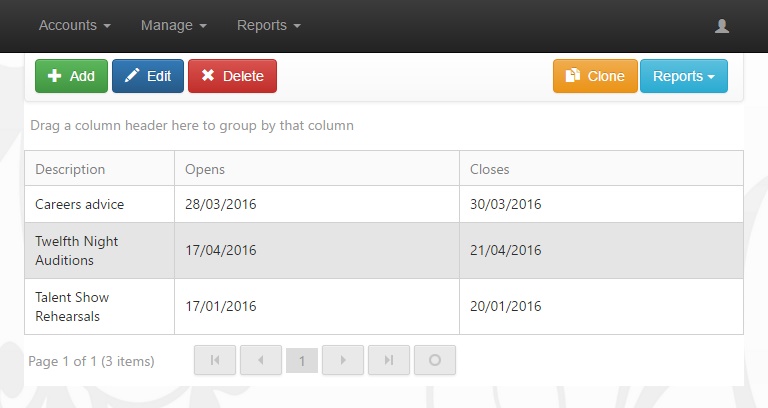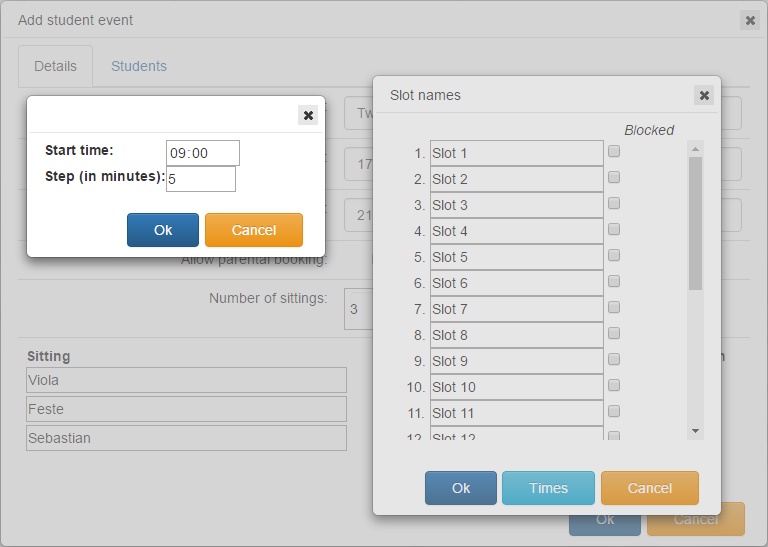Difference between revisions of "Test"
| Line 1: | Line 1: | ||
| − | + | ==Usage== | |
| − | + | {{Additional module}} | |
| + | Student events is an additional module in Insight. It allows students to make a reservation or booking. This could be an appointment to careers advice day or audition for the school play. Alternatively, students could book themselves onto a school trip if there a limited places, or a selection of available trips.. <br> <br> | ||
| − | = | + | As Student events is an additional module of Insight, a separate charge applies. Please contact <span class="plainlinks">[mailto:sales@tascsoftware.co.uk sales@tascsoftware.co.uk]</span> for further information. The Events module also include '''[[Parents evening]]''' and '''[[Events]]'''. <br> <br> |
| − | = | + | =Student events= |
| − | + | Student events are configured via the [[manage student events]] page. <br> <br> | |
| − | + | The student events page will show each of the sessions that are available. There may be multiple sessions available, but each student can only book into one session. In the example below, the session refers to the staff member who is available for a careers advice day. <br> <br> | |
| − | |||
| − | |||
| − | + | Each session will have one or more available slots. Students will be booked into one of these slots. The slots could refer to times during the day, seats on a coach, audition slots, etc. When a student is booked into a slot, a tick will appear next to that slot and it will become unavailable for all other students. <br> <br> | |
| − | + | <div>[[Image:student_event2.jpg]]</div> <br> <br> | |
| − | + | ==Configuration== | |
| − | |||
| − | + | Student events is an additional module in Insight. It allows students to make a reservation or booking. This could be an appointment to careers advice day or audition for the school play. Alternatively, students could book themselves onto a school trip if there a limited places, or a selection of available trips.. <br> <br> | |
| − | |||
| − | + | As Student events is an additional module of Insight, a separate charge applies. Please contact <span class="plainlinks">[mailto:sales@tascsoftware.co.uk sales@tascsoftware.co.uk]</span> for further information. The Events module also include '''[[Parents evening]]''' and '''[[Events]]'''. <br> <br> | |
| − | == | + | ==The Manage student events page== |
| − | + | There are a number of buttons on the top toolbar that allow you to create, manage and edit Student Events. <br> <br> | |
| − | + | <div>[[Image:ManageStudentEvents1.jpg]]</div> <br> <br> | |
| − | |||
| − | + | ==Creating a Student event== | |
| − | + | Click the Add button from the top toolbar to begin creating a student event. This will open a window where you can perform configuration. There are two types of student events; stand alone events and concurrent student events. <br> <br> | |
| − | |||
| − | |||
| − | + | ===Stand alone student events=== | |
| − | + | ====Details tab==== | |
| − | + | A stand alone student event will not be affected by other student events. To create a student event, click the button at the top left with the plus symbol. A window will open where you can configure your event. <br> <br> | |
| − | |||
| − | + | '''Description''' <br> | |
| + | :This is the name of the event - students will be able to see this when making their bookings. <br> <br> | ||
| − | + | '''Open & Close''' <br> | |
| + | :These are the dates where students can make bookings to the event. <br> <br> | ||
| − | + | '''Allow parental booking''' <br> | |
| − | + | :If parents are allowed to make bookings on behalf of the students then use this option; it will allow parental accounts to make bookings as well as students. <br> <br> | |
| − | |||
| − | |||
| − | |||
| − | |||
| − | + | '''Number of sittings''' <br> | |
| + | :Each sitting has its own slots, and it is slots that students will book. If you are creating a career advice event, then the slots might be the names of the staff members who will be available for the event. Each staff member will have their own list of slots that students can book. <br> <br> | ||
| − | + | :Once you have selected the number of sittings, a list will appear at the bottom of the window. Each sitting should be given a name. Each sitting also has a capacity - this is the number of slots that will be available to students. <br> <br> | |
| − | + | :Slots can also be named - typically they will be given names relating to the times of the day that they represent i.e. slot 1 is "9:00", slot 2 is "9:10", etc. To name the slots, click the button under the slot names column. This will open a window - either name the slots by manually typing into the boxes or click the Times button to automatically name the slots as times during the day. <br> <br> | |
| − | + | <div>[[Image:slottimes2.jpg]]</div> <br> <br> | |
| − | |||
| − | + | :You can also give each sitting a description. This provides more information about the sitting. If you are creating a career advice day, then each sitting could represent a staff member, and the description could let the students know which field the staff member knows most about e.g. "IT specialist". <br> <br> | |
| − | |||
| − | |||
| − | |||
| − | |||
| − | |||
| − | |||
| − | == | + | ====Students==== |
| − | + | Finally you need to decide which pupils should be able to make bookings to the event. To do this, click the Students tab at the top of the window. Click the Add students button and select the relevant students. <br> <br> | |
| − | + | ===Concurrent student events=== | |
| − | |||
| − | + | Student events can be configured to interact with each other; this might be used if you want students to select their favourite 3 options from a list of possibilities; if a student makes a booking in a sitting in one event (i.e. a sitting called "Alton Towers") they will not be able to make a booking in the same sitting (again called "Alton Towers") in another event. <br> <br> | |
| − | + | Student events will be configured in the same way as single student events, above. Each of the linked student events will need to have the same start and end date. <br> <br> | |
| − | + | If different events have sittings with the same name as each other (e.g. Event 1 has a sitting called "Alton Towers" and Event 2 has a sitting called "Alton Towers") then pupils will only be able to make one booking to ''either'' of those sittings, even though they are in different events. <br> <br> | |
| − | + | For example, you might create 3 student events, called "1st choice", "2nd choice" and "3rd choice". In each of these events, the list of sittings will represent the different school trips that the students can opt to attend. The number of slots for each sitting represents the number of places available on the trip. If a student makes a booking for "Alton Towers" in the 1st choice event, then they will not be able to book "Alton Towers" in their 2nd or 3rd choice, although the other school trips will still be available. <br> <br> | |
| − | |||
| − | |||
| − | |||
| − | |||
| − | |||
| − | |||
| − | |||
| − | |||
| − | |||
| − | |||
| − | |||
| − | |||
| − | |||
| − | |||
| − | |||
| + | [[Category:Management]] | ||
[[Category:Additional modules]] | [[Category:Additional modules]] | ||
| − | |||
| − | |||
Revision as of 14:53, 10 August 2018
Contents
Usage
| Additional Module |
Student events is an additional module in Insight. It allows students to make a reservation or booking. This could be an appointment to careers advice day or audition for the school play. Alternatively, students could book themselves onto a school trip if there a limited places, or a selection of available trips..
As Student events is an additional module of Insight, a separate charge applies. Please contact sales@tascsoftware.co.uk for further information. The Events module also include Parents evening and Events.
Student events
Student events are configured via the manage student events page.
The student events page will show each of the sessions that are available. There may be multiple sessions available, but each student can only book into one session. In the example below, the session refers to the staff member who is available for a careers advice day.
Each session will have one or more available slots. Students will be booked into one of these slots. The slots could refer to times during the day, seats on a coach, audition slots, etc. When a student is booked into a slot, a tick will appear next to that slot and it will become unavailable for all other students.
Configuration
Student events is an additional module in Insight. It allows students to make a reservation or booking. This could be an appointment to careers advice day or audition for the school play. Alternatively, students could book themselves onto a school trip if there a limited places, or a selection of available trips..
As Student events is an additional module of Insight, a separate charge applies. Please contact sales@tascsoftware.co.uk for further information. The Events module also include Parents evening and Events.
The Manage student events page
There are a number of buttons on the top toolbar that allow you to create, manage and edit Student Events.
Creating a Student event
Click the Add button from the top toolbar to begin creating a student event. This will open a window where you can perform configuration. There are two types of student events; stand alone events and concurrent student events.
Stand alone student events
Details tab
A stand alone student event will not be affected by other student events. To create a student event, click the button at the top left with the plus symbol. A window will open where you can configure your event.
Description
- This is the name of the event - students will be able to see this when making their bookings.
Open & Close
- These are the dates where students can make bookings to the event.
Allow parental booking
- If parents are allowed to make bookings on behalf of the students then use this option; it will allow parental accounts to make bookings as well as students.
Number of sittings
- Each sitting has its own slots, and it is slots that students will book. If you are creating a career advice event, then the slots might be the names of the staff members who will be available for the event. Each staff member will have their own list of slots that students can book.
- Once you have selected the number of sittings, a list will appear at the bottom of the window. Each sitting should be given a name. Each sitting also has a capacity - this is the number of slots that will be available to students.
- Slots can also be named - typically they will be given names relating to the times of the day that they represent i.e. slot 1 is "9:00", slot 2 is "9:10", etc. To name the slots, click the button under the slot names column. This will open a window - either name the slots by manually typing into the boxes or click the Times button to automatically name the slots as times during the day.
- You can also give each sitting a description. This provides more information about the sitting. If you are creating a career advice day, then each sitting could represent a staff member, and the description could let the students know which field the staff member knows most about e.g. "IT specialist".
Students
Finally you need to decide which pupils should be able to make bookings to the event. To do this, click the Students tab at the top of the window. Click the Add students button and select the relevant students.
Concurrent student events
Student events can be configured to interact with each other; this might be used if you want students to select their favourite 3 options from a list of possibilities; if a student makes a booking in a sitting in one event (i.e. a sitting called "Alton Towers") they will not be able to make a booking in the same sitting (again called "Alton Towers") in another event.
Student events will be configured in the same way as single student events, above. Each of the linked student events will need to have the same start and end date.
If different events have sittings with the same name as each other (e.g. Event 1 has a sitting called "Alton Towers" and Event 2 has a sitting called "Alton Towers") then pupils will only be able to make one booking to either of those sittings, even though they are in different events.
For example, you might create 3 student events, called "1st choice", "2nd choice" and "3rd choice". In each of these events, the list of sittings will represent the different school trips that the students can opt to attend. The number of slots for each sitting represents the number of places available on the trip. If a student makes a booking for "Alton Towers" in the 1st choice event, then they will not be able to book "Alton Towers" in their 2nd or 3rd choice, although the other school trips will still be available.


